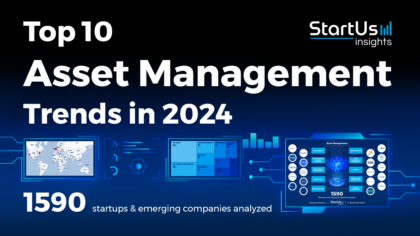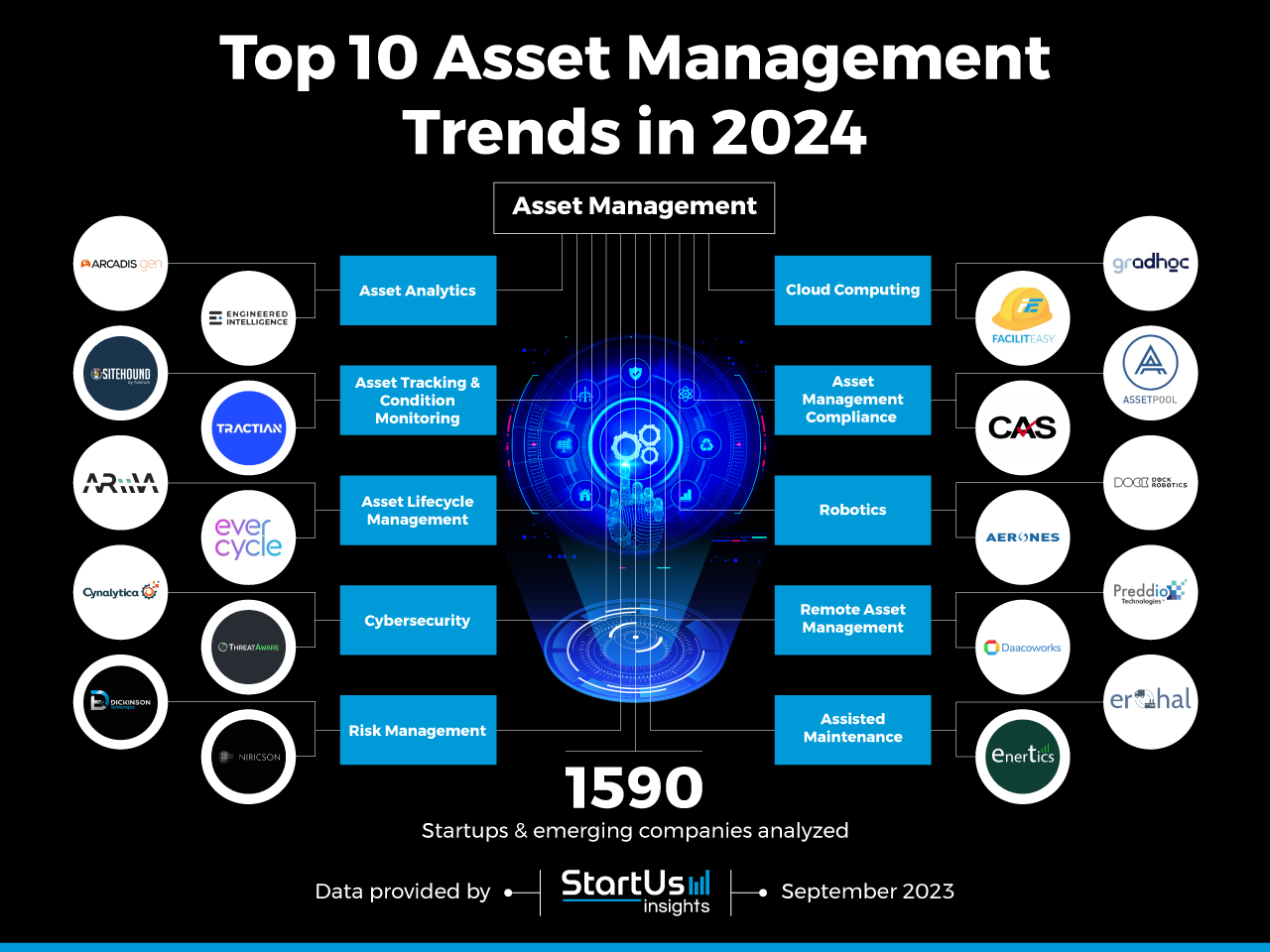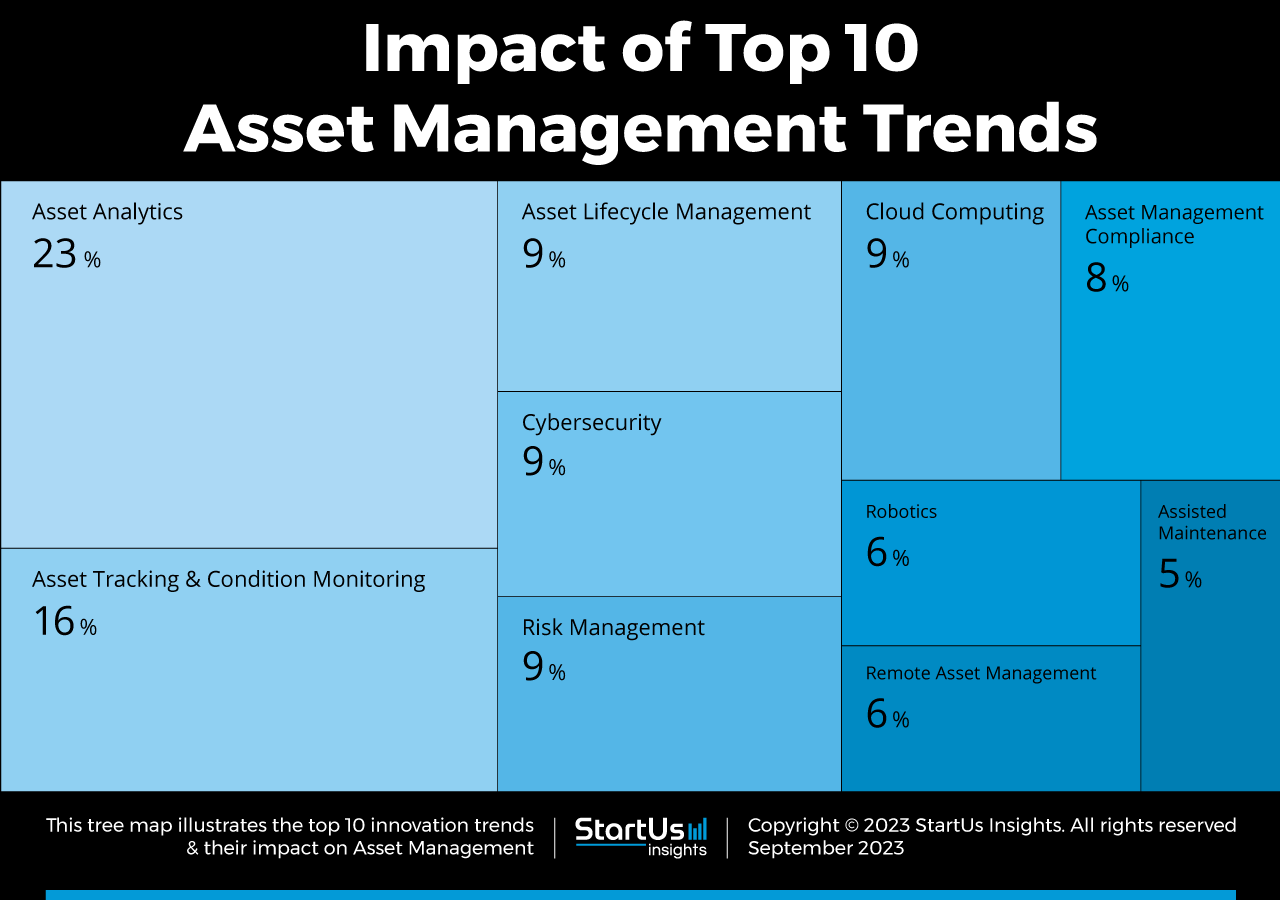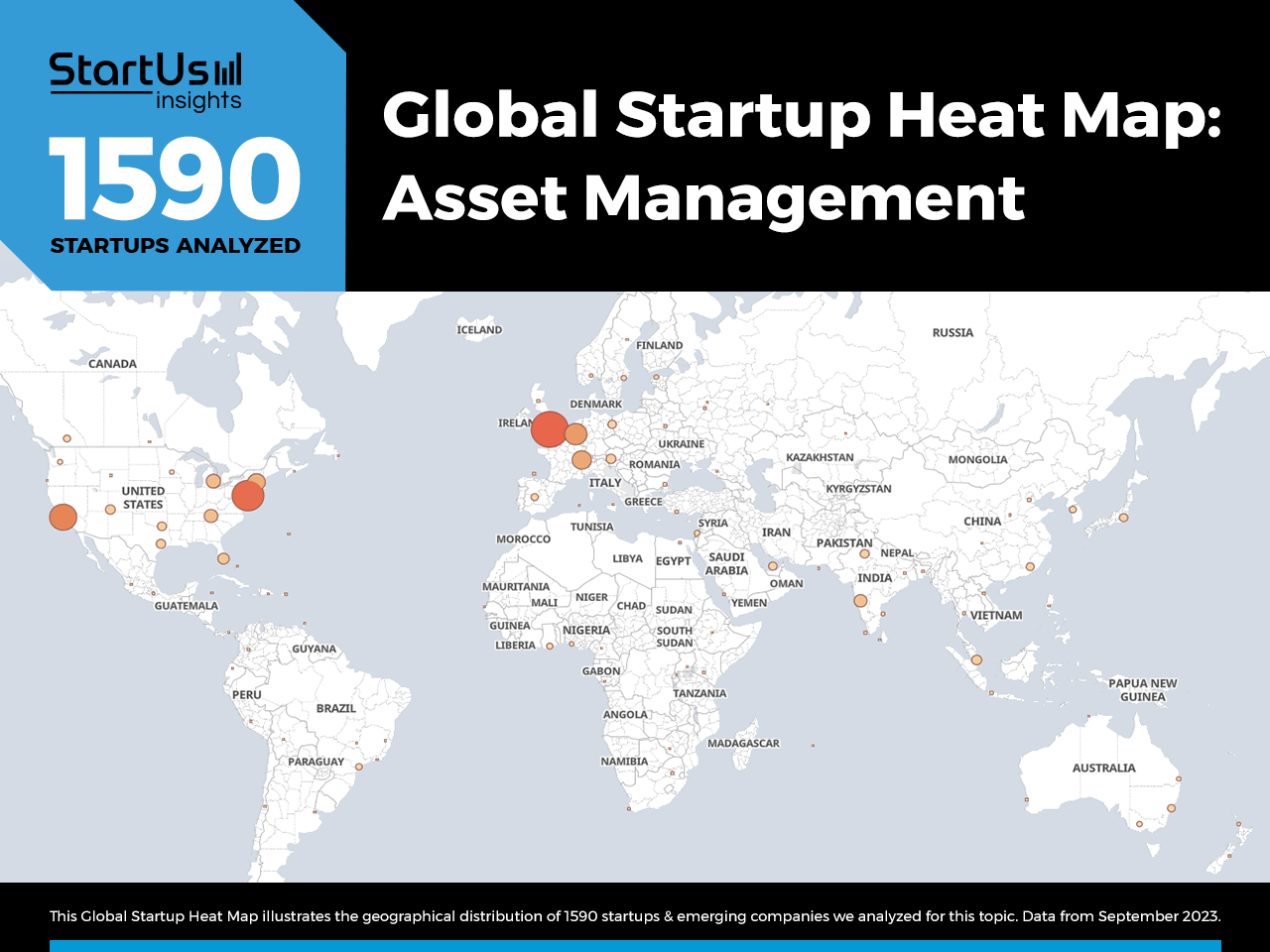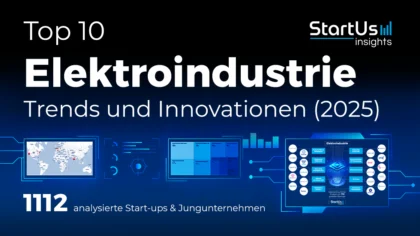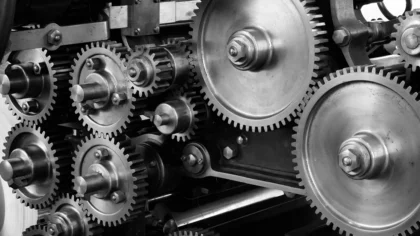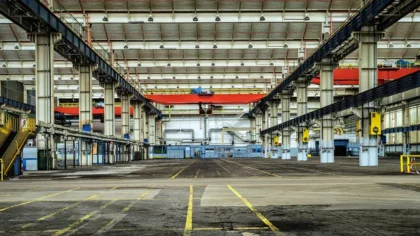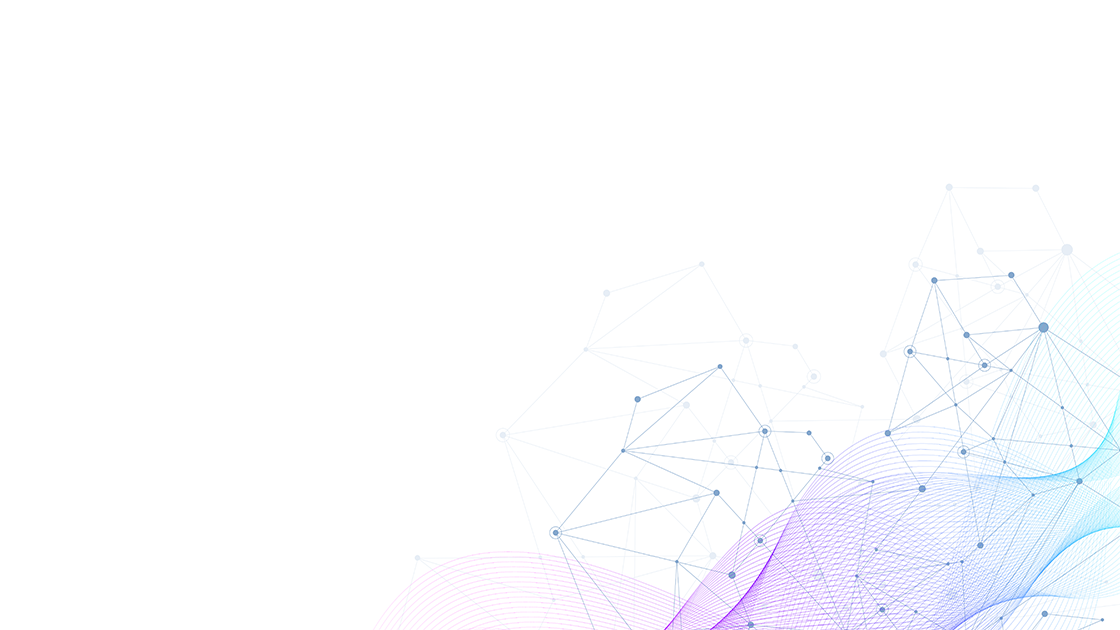Industry 4.0 and rapid digitalization require businesses to deal with massive amounts of data and centralize asset management. This includes optimizing asset life cycles, following maintenance schedules, adhering to ever-evolving regulatory standards, asset disposal procedures, and much more. To ensure efficient asset management, companies are leveraging technologies like advanced tracking, predictive maintenance tools, and asset lifecycle management software.
These innovations mitigate the prevalent problems and also provide substantial benefits to the industry by enhancing operational efficiency, reducing costs, and improving asset availability. Read more to explore all asset management trends and find out how they impact your business.
What are the latest trends in asset management?
- Asset Analytics
- Asset Tracking & Condition Monitoring
- Asset Lifecycle Management
- Cybersecurity
- Risk Management
- Cloud Computing
- Asset Management Compliance
- Robotics
- Remote Asset Management
- Assisted Maintenance
Innovation Map outlines the Top Asset Management Trends & 20 Promising Startups
For this in-depth research on the Top Asset Management Industry Trends, we analyzed a sample of 1590 global startups & scaleups. This data-driven research provides innovation intelligence that helps you improve strategic decision-making by giving you an overview of emerging technologies across industries. In the Asset Management Innovation Map below, you get a comprehensive overview of the innovation trends & startups that impact your company.
These insights are derived by working with our Big Data & Artificial Intelligence-powered StartUs Insights Discovery Platform, covering 3 790 000+ startups & scaleups globally. As the world’s largest resource for data on emerging companies, the SaaS platform enables you to identify relevant technologies and industry trends quickly & exhaustively.
Tree Map reveals the Impact of the Top Asset Management Trends in 2024
Based on the Asset Management Innovation Map, the Tree Map below illustrates the impact of the Top 10 Trends in Asset Management in 2024. Asset analytics solutions use data from multiple sources to provide insights into asset performance and utilization, enabling proactive maintenance. Concurrently, asset tracking and condition monitoring, such as IoT sensors, are offering real-time visibility into asset conditions, enhancing equipment reliability.
Advanced lifecycle management tools are optimizing the entire asset life, from acquisition to disposal, ensuring maximum value extraction. The integration of cybersecurity measures is also safeguarding assets against evolving digital threats and closing potential loopholes from connected assets. Further, risk management solutions assist in identifying and mitigating potential operational risks to prevent significant monetary losses while cloud computing is facilitating scalable and flexible asset management.
Robotics is automating tasks like installation and maintenance to improve operational efficiency and reduce human errors. Besides these, remote asset management technologies allow monitoring and management of assets even in hazardous environments from distant locations. Lastly, assisted maintenance technologies employ AR, AI, and more to guide maintenance personnel and reduce downtime.
Global Startup Heat Map covers 1590 Asset Management Startups & Scaleups
The Global Startup Heat Map below highlights the global distribution of the 1590 exemplary startups & scaleups that we analyzed for this research. Created through the StartUs Insights Discovery Platform, the Heat Map reveals high startup activity in the UK and the US, followed by the rest of Western Europe.
Below, you get to meet 20 out of these 1590 promising startups & scaleups as well as the solutions they develop. These asset management startups are hand-picked based on criteria such as founding year, location, funding raised & more. Depending on your specific needs, your top picks might look entirely different.
Interested to explore all 1500+ asset management companies?
10 Emerging Asset Management Trends in 2024
1. Asset Analytics
Inaccuracy in asset tracking and utilization leads to substantial resource wastage and decreased productivity across sectors. This issue is addressed through innovations in asset analytics that utilize interactive visualizations and dashboards to enable real-time monitoring. For this, companies leverage data processing solutions like AI and machine learning.
For instance, analyzing real-time data on asset conditions and performance using AI allows for more informed and timely decision-making processes. This asset management technology fosters a more proactive and data-driven approach to asset management, mitigating inefficiencies and enhancing overall operational effectiveness.
Arcadis Gen develops an Enterprise Decision Analytics Platform
UK-based startup Arcadis Gen optimizes asset investment decisions through its Enterprise Decision Analytics (EDA) platform. It integrates disparate data sources to build and analyze asset models and optimize data to provide insights for executives at decision-making levels.
Moreover, it features advanced technologies like machine learning, AI, and complex optimization solvers to model the lifecycle of assets and predict future asset performance. EDA is applicable to both short and long-term planning and handles linear and vertical assets. The platform provides a flexible solution that adheres to multiple constraints and delivers real-time results.
Engineered Intelligence offers Energy Asset Analytics
Canadian startup Engineered Intelligence specializes in advanced analytics solutions for electric power systems while enhancing asset management processes. The startup’s platform ENGIN provides comprehensive analytics covering aspects from asset condition assessment to failure consequence analytics and cash flow analytics. It also centralizes various data sources to provide a complete overview of asset performance through an easy-to-navigate interface.
Further, the cloud-based platform integrates with various technologies and systems of their clients to exchange data without any issues. Engineered Intelligence’s platform allows organizations to manage risks and make better-informed decisions faster and more consistently for their critical power infrastructure.
2. Asset Tracking & Condition Monitoring
The lack of real-time visibility into asset location and condition is a leading factor in operational disruptions and increased maintenance costs. Therefore, asset tracking and condition monitoring technologies resolve this issue using the Internet of Things (IoT), RFID, and GPS, which provide real-time asset intelligence. Additionally, condition monitoring tools assess the state of equipment and infrastructure continuously to identify any deviations from optimal performance.
For example, some asset condition monitoring solutions alert managers on unauthorized asset movement or deteriorating asset health. This allows for immediate corrective actions and preventive maintenance. By leveraging these advanced tracking and monitoring technologies, organizations enhance asset reliability, minimize downtime, and optimize asset life cycles.
Sitehound develops Asset Tracking Software
US-based startup Sitehound builds asset management and tracking software that improves the visibility of inventory. It leverages AI to provide real-time insights and ensures optimal utilization of resources, enhancing overall productivity. The software also features software licensing asset management, enabling organizations to understand and manage software license compliance and unauthorized software usage.
The startup’s software is accessible via web and mobile, facilitating team collaboration and asset management from anywhere. Besides, it provides real-time updates and comprehensive asset histories while allowing asset managers to configure tracking forms and create custom fields to simply inventory management. It thus enables companies to enhance their operational efficiency and asset management through mapping, tracking, reporting, and workflow automation.
TRACTIAN creates an Intelligent Energy Sensor
US-based startup TRACTIAN offers intelligent energy sensors to prevent electrical and mechanical failures by providing control over energy consumption. The startup’s Energy Trac sensor provides real-time access to information about the energy quality of operations and power grid indicators through non-invasive measurement technology. It also offers 24-hour monitoring with insights into current, voltage, power, and consumption data at any time of the day.
Besides, the sensor monitors a wide range of electrical assets including electrical panels, pumps, generators, furnaces, engines, compressors, and transformers. In the asset management industry, it is essential to understand consumption patterns, improve productivity, and avoid fines. By combining IoT and AI, TRACTIAN’s solutions enable machine operators to prevent expensive breakdowns and maintenance teams to create better maintenance plans.
3. Asset Lifecycle Management
The inability to accurately predict the end-of-life of assets causes premature disposal and replacement costs or increased maintenance and operational costs. To maximize asset utilization, businesses integrate end-to-end lifecycle management systems that offer insights into machine or asset status to make informed decisions on asset maintenance and disposal.
To aid this, companies develop solutions powered by predictive analytics and machine learning that analyze various asset data points. These models accurately project the degradation curve of assets, allowing organizations to make informed decisions on asset refurbishment, resale, or decommissioning. This precision in determining asset end-of-life reduces unnecessary expenditures related to untimely asset replacements while promoting sustainable and economically efficient operations.
ARiiVA provides an Augmented Reality Service Platform
Austrian startup ARiiVA creates an AR service platform for the real-time management of physical and digital inventory. It encompasses the entire lifecycle of an asset beginning with real-time visualization using live sensor data. The platform also allows maintenance teams and asset managers to capture data on assets through a connected mobile application. Further, it identifies performance issues and optimization areas, facilitating improvements in asset tracking and project closing times, while reducing errors, delays, and setbacks.
Additionally, AriiVA’s platform ensures data transparency between client and supplier through features like in-app-live calls and data exchange along with in-app tracking of energy and carbon consumption. This assists in extending device lifecycles and optimizes logistics to limit travel times. The platform serves as a comprehensive solution for unstructured and inefficient service processes, offering a sustainable reduction of operative service costs.
Evercycle advances Device Lifecycle Orchestration
US-based startup Evercycle automates IT device lifecycle services through its platform. The platform enables enterprises to orchestrate lifecycle services for managed devices while integrating service providers, tools, tracking, and reporting and simplifying workflows. The startup also offers solutions that are essential for IT asset disposition (ITAD) and hardware services such as automated reverse logistics and end-to-end traceability.
Further, the platform enables enterprises to view the parameters of their devices such as current value, condition, grade, and so on for forecasting and planning lifecycle services. Evercycle enables efficient device management and mitigates data security risks across devices while facilitating device recovery and management.
4. Cybersecurity
Modern enterprise, manufacturing, and production systems face an escalating threat of cyber-attacks, targeting the integrity and confidentiality of business data. This results in unauthorized access, data breaches, and subsequent operational and reputational damage. To prevent this, startups are providing advanced threat detection and response solutions, employing advanced algorithms to identify and counteract malicious activities rapidly.
For instance, behavioral analytics monitors user activities and detects anomalous behavior that indicates a security compromise. Endpoint detection and response solutions are also implemented to rapidly identify and neutralize threats at the device level. These cybersecurity innovations are important in safeguarding asset information and ensuring the resilience and reliability of asset-heavy industries.
Cynalytica provides Critical Infrastructure Cybersecurity
US-based startup Cynalytica offers advanced industrial control with cybersecurity-centric hardware and software to protect critical infrastructure. The startup’s products include the SerialGuard AnalytICS Platform, a fully passive operational health monitoring and anomaly detection solution that provides visibility of high-risk cyber-physical assets. It features passive monitoring, secure communication, and real-time alerting while integrating with third-party SIEM and SOAR platforms.
Additionally, its OT OptICS is an AI-driven intrusion detection system for serial-connected industrial control systems that protects legacy cyber-physical systems. It features real-time monitoring, autonomous network surveillance, and alerting with machine learning. The platform is protocol-agnostic and offers deep packet inspection support for various serial networks. These solutions prevent malicious attacks on cyber-physical systems, thereby mitigating unplanned downtime.
ThreatAware offers Cyber Asset Management
UK-based startup ThreatAware specializes in solutions to enhance cyber asset security. Its platform utilizes API feeds to validate that device controls are correctly deployed and functioning across all cyber assets, offering clarity on security control health. It is also agentless and creates accurate device inventory by connecting to existing systems via API and triggering actions through a webhook when issues arise.
Moreover, the cloud-based and vendor-agnostic platform integrates with various security and IT tools. The platform also contains customizable workflow automation like tailored notifications and automatic remediation plans in the case of an issue. ThreatAware’s platform allows organizations to manage cyber risk and ensure that all their assets accessing corporate data are legitimate and protected.
5. Risk Management
Inadequate assessment and mitigation of both micro and macro-scale risks associated with asset failures and downtimes is a significant cause of operational disruptions and financial losses. Asset managers now recognize that comprehensive risk management, encompassing operational and regulatory risks to market and environmental factors, is critical. By prioritizing risk management, asset-heavy industries safeguard their substantial investments, optimize asset utilization, streamline maintenance, and proactively address vulnerabilities.
Therefore, businesses leverage risk management systems to identify potential risk factors and assess their impact on asset performance and reliability. Moreover, these innovations enable the development of dynamic risk models that adapt to changing operational conditions and provide early failure warnings. By implementing proactive risk management strategies, organizations allocate resources more efficiently and implement contingency plans to minimize the impact of unforeseen asset-related disruptions.
Dickinson Technologies advances Cloud-based Industrial Risk Management
South African scaleup Dickinson Technologies develops digital asset management solutions that focus on industrial risks and minimizing losses from unplanned downtimes. The startup’s solutions employ complex analytical systems, utilizing both maintenance and operational data to safeguard assets. They provide early warnings for assets at risk of failure or performance issues, enabling proactive intervention and preventing expensive reactive measures.
The startup’s Bearing Fault Early Warning system continuously monitors the vibrations and speeds of machines predicting bearing failures through algorithms. Additionally, its customizable Digital Workshop Management software improves the efficiency of work order processes, offering a database engine to store and analyze all work orders. These solutions prevent unplanned maintenance and production halts as well as subsequently protect organizations from incurring financial losses.
Niricson provides AI-based Predictive Analytics
Canadian startup Niricson develops an AI-backed platform, AUTOSPEX, for infrastructure condition assessment. It performs automated defect detection, quantification, and tracking assisted by AI and data fusion. It pairs with DRONIC, a patented data collection and fusion architecture, and a drone equipped with a concrete-sounding hammer to gather comprehensive condition and deterioration information.
Moreover, AUTOSPEX enables the mapping and quantification of damage on concrete structures and tracks them over time, providing valuable insights for asset owners. Niricson’s predictive analytics platform allows critical asset owners and managers to monitor changes over time and make informed decisions to enhance infrastructure safety.
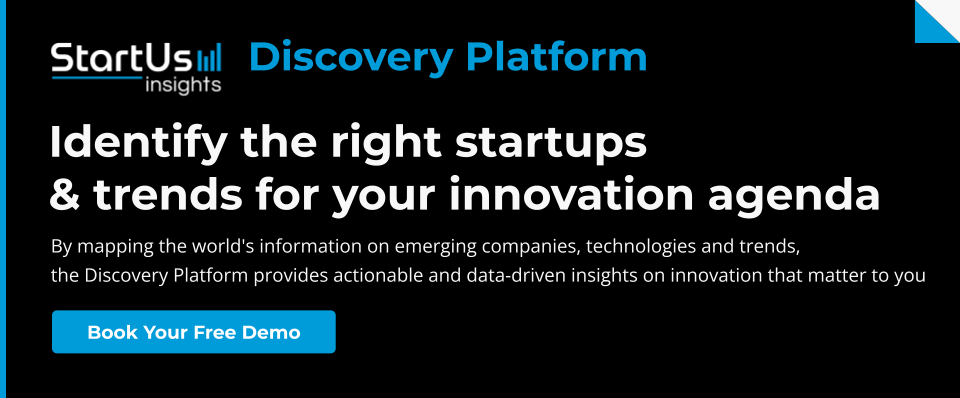
6. Cloud Computing
Many modern companies have assets distributed in multiple regions of the world that generate vast amounts of data. This creates a limitation imposed by traditional IT infrastructures, thereby hindering the scalability, accessibility, and real-time processing of asset data. Cloud computing overcomes this issue by providing scalable and flexible computing resources over the internet, enabling organizations to efficiently store, process, and analyze vast amounts of asset data in real-time.
For example, cloud-based asset management solutions enable seamless integration of data from diverse sources, facilitating real-time analytics and insights. Moreover, these insights are accessible from anywhere, enhancing collaboration and decision-making processes related to asset optimization, maintenance, and allocation.
Gradhoc Smart specializes in Cloud-based Refrigeration and Climatization Systems
Gradhoc is a Spanish startup that creates a cloud-based platform that combines IoT, digital twins, and AI to manage assets related to refrigeration and climatization. It enables real-time readout and data records of all variables related to existing assets, providing visualization of machine rooms, cold rooms, and services supplied with cold. The platform also features predictive maintenance through the platform’s AI which detects patterns or onset of malfunctions.
Further, the platform performs smart energy management by adjusting defrost and floating condensation with adaptive optimization of setpoints. Besides, the cloud platform enables cold chain managers and operators to receive reports and manage their cooling systems. Through digital twins, Gradhoc compares asset behavior between their optimal and actual states to further optimize the performance of refrigeration systems. This solution, in turn, finds applications in ensuring food safety and minimizing the loss of goods.
Faciliteasy creates Asset Maintenance Management Software
Faciliteasy is an Indian startup that develops cloud-based asset maintenance management software to streamline technicians’ on-the-go work management. The software features asset assignment, maintenance tracking, QR code generation, repair tracking, task management, service contracts, and meter readings. It also enables technicians to manage assets, scan QR codes, assign tasks, perform audits, and execute an array of actions directly from mobile devices.
Moreover, asset maintenance data is uploaded and stored on the cloud and offers both technicians and managers access to the updated data. This approach provides real-time updates and high flexibility to on-the-field teams, ensuring effective management of assets. The software thus keeps track of company assets, extends their lifecycle performance, reduces downtime, and saves on maintenance costs.
7. Asset Management Compliance
The complexity and variability in compliance requirements between states, countries, and regions increase the likelihood of non-compliance. This may be due to a variety of factors including overlooking regulatory obligations, resulting in severe penalties and reputational damage. Asset management compliance solutions prevent this by enabling the development of dynamic compliance frameworks that adapt to the changing regulatory landscape and automatically align asset management practices with the latest compliance standards.
Automated compliance checklists and real-time alert systems are implemented to promptly identify and address any deviations from compliance norms. This ensures continuous adherence to regulatory requirements. Such innovations in compliance management are important in mitigating legal and reputational risks and fostering organizational integrity.
AssetPool enables Automated Asset Compliance
AssetPool is a Canadian startup specializing in automated asset compliance and verification software to optimize asset management and inspection. Each asset is uniquely identified with a QR code, allowing for individual tracking and treatment. This ensures an up-to-date asset register at all times. Moreover, it creates a fail-proof workflow for compliance tasks that enhances operational efficiency and safety by centralizing all safety documents in one location.
The software is customizable, allowing organizations to input asset types and checklists specific to business and complaint requirements and organize client sites in real-time. AssetPool facilitates the scheduling of single or recurring jobs, aiding in the maintenance and monitoring of assets. Further, the platform changes manual, paper-based processes to a fully digitalized platform which enhances accuracy in managing, tracking, and measuring assets.
CAS offers Cloud-based Automated Compliance Audits
CAS is a New Zealand-based startup that enables smart lifecycle management of assets through its ACABIM compliance platform. The cloud-based platform serves as a central location to manage compliance checks of construction projects during the design workflow. It supports compliant land development and planning solutions as well as integrates facilities and asset management tools.
The software also contains features to share BIM data, perform calculations, and maintain built assets efficiently, emphasizing compliance-centric design. The platform aids in pre-validating consent submissions and visualizing the impact of changes, optimizing the design experience.
8. Robotics
The manual handling and maintenance of assets is time-consuming, prone to errors, and inefficient, especially in environments that are hazardous or hard to reach. Robotics are addressing this by introducing autonomous robots equipped with advanced sensors and AI to perform asset inspections, maintenance, and data collection tasks. For example, drones access high or remote locations to inspect asset conditions while robotic arms perform precise maintenance tasks in hazardous environments.
Robotic systems thus reduce human exposure to risks. These robotic solutions enhance the accuracy and efficiency of asset management tasks and also enable real-time data acquisition and analysis. This also facilitates proactive asset maintenance and informed decision-making on asset lifecycles, optimizing asset longevity and operational productivity.
Dock Robotics manufactures Autonomous Inspection Robots
Dock Robotics is a UK-based startup that develops autonomous inspection robots for optimizing asset management through advanced analytics and high-quality data acquisition. The robots are equipped with 2D LiDAR sensors and 3D mapping cameras, enabling precise data acquisition and autonomous navigation. Besides, the robot supports both manual controlling and autonomous navigation.
Dock Robotics’ maintenance solution also features an intuitive interface that allows for easy setup, use, and adaptation while providing insights through a web-based analytics dashboard. The robots assist in acquiring reliable inspection data and insights, especially in hazardous environments such as heavy asset industries.
Aerones creates Robotic Wind Turbine Care Systems
Latvian startup Aerones makes robotic wind turbine care systems, focusing on maintenance, inspection, and repairs. The startup utilizes patented robotic technology and tools that are controlled and monitored by technicians from the ground. This ensures safety and precision with the robotic system capable of functioning in diverse conditions, including rainy weather.
The robots also generate detailed blade inspection data such as corrosion, cracks, and physical damage, and are able to perform repairs. Besides, the cloud platform features datasets from inspections that enable the creation of better preventive maintenance plans and budgets. Aerones robotics solution allows wind turbine owners and operators to ensure their assets’ longevity with optimal performance.
9. Remote Asset Management
Globalization of companies and their assets creates inefficiencies and inaccuracy in managing assets that are dispersed across various locations and also presents additional operational complexities. This is why startups are creating remote asset management solutions that employ advanced technologies like IoT, cloud computing, and more to monitor, control, and manage assets from a centralized location. For instance, sensors attached to assets relay real-time data on asset performance and condition to a centralized system.
Remote asset management solutions thus allow managers to detect anomalies, schedule maintenance, and make informed decisions promptly. This centralized and real-time approach to asset management reduces downtime and costs as well as enhances the overall equipment efficiency (OEE) and responsiveness of assets. Consequently, organizations are able to adapt swiftly to changing operational needs.
Preddio Technologies builds Digital Twins of Assets
Preddio Technologies is a US-based startup that develops digital twin technology, Simplicity, to continuously monitor and improve asset performance. It functions through the use of quick-to-install SIMPLICITY NANO wireless sensors that provide data on temperature, vibration, and water. The startup also provides SIMLICITY LINK that connects to hardwired analog sensors and turns them into wireless beacons.
Besides, Simplicity Cloud and Simplicity Mobile provide real-time data access to review and configure digital twins as well as set alarm thresholds from anywhere. Preddio Technology’s solution assists in identifying hidden opportunities and making informed decisions about assets based on data-driven actionable data.
Daacoworks develops Operations and Maintenance Management Software
Daacoworks is an Indian startup that provides a digital platform, Prism, to manage operations and maintenance. It contains a range of functionalities including breakdown, preventive, and predictive maintenance, assets and spare parts inventory management, and smart team collaboration. Besides, Prism IoT Edge is a gateway that supports a wide range of industry-standard communication protocols, allowing real-time data collection from sensors and PLCs.
The platform also features web-based SCADA to visualize industrial processes and enables their monitoring from any location. Daacowork’s software provides secure remote access to industrial operational technology network devices like robots, CNC machines, HMIs, etc. through secure virtual private networks (VPN).
10. Assisted Maintenance
Current over-reliance on manual and reactive maintenance strategies leads to delayed or inadequate maintenance interventions. This causes prolonged equipment downtimes and increased wear and tear on assets. Therefore, startups are integrating advanced diagnostic tools and predictive maintenance technologies that feature intelligent sensors and advanced monitoring.
They detect early signs of malfunction or degradation in assets, enabling timely and precise maintenance interventions. These technologies facilitate the transition from reactive to proactive maintenance strategies. As a result, asset managers are able to optimize maintenance schedules, reduce unplanned downtimes, and extend asset lifespan.
Erohal delivers IoT-powered Inspections
UAE-based startup Erohal provides a cloud-based solution for IoT-powered automated inspections and AI-induced issue identifications in fleet assets and facilities. The startup’s technology detects abnormalities and likely issues at an early stage, offering recommendations and possible solutions. It also features real-time location, instant notifications, and image verification to improve the asset management process.
Besides predictive analytics and vehicular asset tracking, the platform manages service history, assigns work orders, and suggests corrective measures to fix problems. Through the use of AI and IoT in asset maintenance, Erohal’s solution prevents major failures, downtime, and inefficiencies for vehicle fleets.
Enertics makes an Operations Intelligence System
Enertics is a Canadian startup that offers operations intelligence systems to enhance asset management through advanced monitoring and predictive maintenance. The startup’s solutions include the eM Saver hardware and eM AISuite software platform, which provide asset health monitoring, diagnostics, and predictive analytics.
These solutions integrate advanced sensing, connectivity, and data analytics to enable condition-based maintenance (CbM) when real-time metrics reflect abnormalities or signals of declining performance. The solutions are deployable in a short duration for both brownfield and greenfield applications, ensuring optimal return on investment.
Discover all Asset Management Trends, Technologies & Startups
Blockchain technology offers enhanced security and transparency in asset transactions and ownership records. Additionally, digital twins are enabling the creation of dynamic virtual representations of physical assets, allowing for improved monitoring, analysis, and control. Further, advances in the IoT enable greater interconnectivity of assets and provide more asset performance parameters in real-time.
The Asset Management Trends & Startups outlined in this report only scratch the surface of trends that we identified during our data-driven innovation & startup scouting process. Identifying new opportunities & emerging technologies to implement into your business goes a long way in gaining a competitive advantage.
